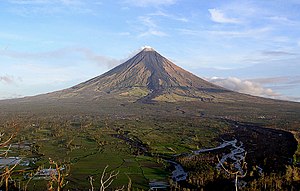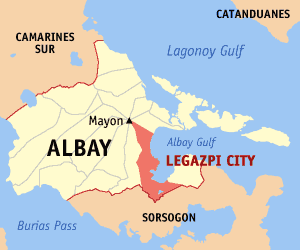Mayon
| Mayon | ||
|---|---|---|
|
Mayon on December 13, 2006 |
||
| height | 2462 m | |
| location | Bicol Region , Philippines | |
| Coordinates | 13 ° 15 '24 " N , 123 ° 41' 6" E | |
|
|
||
| Type | Stratovolcano | |
| Last eruption | January 2018 | |
|
Pyroclastic currents during the Mayon eruption on September 23, 1984 |
||
|
Location of Mayon in the province of Albay, Bicol |
||
The Mayon is a 2,462 meter high volcano in the Philippines , about 330 kilometers southeast of the capital Manila . It is located in the Bicol region on the southeastern foothills of the main island of Luzon, not far from the city of Legazpi and the municipality of Daraga .
Location and structure
The Mayon lies west of the Philippines Trench , a subduction zone in which the Filipino plunges under the Eurasian plate . The upper slopes of from andesitic lava and pyroclastic constructed layer volcano have slopes of 35 to 40 °. The 100 meter deep volcanic crater has a diameter of 500 meters. Because of its almost perfectly shaped cone , it is often referred to as the most beautiful volcano in the world.
outbreaks
1814 and further eruptions
The Mayon erupted over 50 times in the last 400 years, making it by far the most active volcano in the Philippines. The eruptions of the past 300 years have been concentrated on the south-east slope, so that the south and east slopes are bare and the other slopes are covered with vegetation. The cause is the Bonga Gully , a gorge deepened in the southeast of the summit. The ejecta from the summit crater collects in it. When the capacity of the gorge is exhausted or further eruptions cause tremors, glowing clouds and glowing avalanches tumble down the southeast slope.
One of the most devastating eruptions occurred on February 1, 1814, when 1200 people died, mostly from pyroclastic currents and lahars . The city of Cagsawa was destroyed. Other eruptions that claimed high numbers of victims were in 1897 (around 350 deaths from ash , pyroclastic flows and lahars) and 1993 (75 deaths from pyroclastic flows).
21st century
In August 2006, around 40,000 people were temporarily evacuated from the vicinity of the volcano after ash eruptions and the escape of lava had occurred since the previous month . The eruptions subsided in September; The lava leak ended at the beginning of October 2006.
On the night of December 1, 2006, heavy rains from Typhoon Durian triggered huge streams of mud called cold lahars. 1266 people have died or have been missing since then. In June 1981 at least 200 people had been killed by cold lahars.
In December 2009, around 47,000 people were evacuated for three weeks. The reason was ash eruptions from Mayon, which began in September 2009 and intensified in December. Lava also leaked out.
On the morning of May 7, 2013, at least five people - tourists and mountain guides, including three Germans - were killed on Mayon by falling rocks. The Philippine Institute of Volcanology and Seismology classified this activity of the volcano as a phreatic explosion and refrained from issuing a warning of an eruption with magma outflow. Nevertheless, the public was warned not to enter a six-kilometer-wide safety zone, as such outbreaks could be expected at any time. In 2014 lava also flowed out of the mountain and a total of 63,000 people fled.
On January 13 or 14, 2018, a 2,500 meter high ash column formed over the volcano. More than 4,400 people from the area, including residents of the villages of Guinobatan, Camalig and Cabangan, fled the ash rain. Due to the dense cloud cover, the authorities are currently unable to assess its extent. On January 22, 2018, the volcanology authority warned of an "imminent" eruption. 40,000 people have already fled, and ashes are raining on Legazpi City , which has a population of 200,000 .
From mid-January to mid-February 2018, the volcano erupted several times a day with glowing tephra up to 600 meters above the crater, ash clouds up to 6 kilometers high, and it also generated lava flows and pyroclastic flows. The emission of SO 2 was around 1000 to 2500 tons per day. On March 6, 2018, Phivolcs downgraded the Mayon alarm status from 4 to 3. After a few days of relative calm, the mayon began again pouring lava and clouds of ash on March 23.
Mayon Volcano National Park
The area around the Mayon was declared Mayon Volcano National Park in 2000 on an area of 58 km².
See also
Individual evidence
- ^ A b Hans Pichler: volcanic areas of the earth. Elsevier, Munich 2007, ISBN 978-3-8274-1475-5 , p. 204.
- ^ Entry in The Significant Volcanic Eruption Database of NOAA (English, accessed on February 22, 2013).
- ^ Entry in 1993 in The Significant Volcanic Eruption Database of NOAA (English, accessed on January 28, 2018).
- ↑ Monthly reports 03/2006 to 05/2007 in the Global Volcanism Program (English, accessed on February 23, 2013).
- ^ Entry in The Significant Volcanic Eruption Database of NOAA (English, accessed on February 22, 2013).
- ^ Entry in The Significant Volcanic Eruption Database of NOAA (English, accessed on February 23, 2013).
- ↑ Monthly reports 10/2009 and 12/2009 in the Global Volcanism Program (English, accessed on February 23, 2013).
- ↑ Three Germans killed in volcanic eruption ( Memento from June 7, 2013 in the Internet Archive ) Tagesschau May 7, 2013, accessed on May 7, 2013
- ↑ Five dead, one Austrian injured. In: ORF.at , May 7, 2013
- ↑ Mayon Volcano Advisory May 7, 2013, 8:30 am from the Philippine Institute of Volcanology and Seismology. Retrieved May 7, 2013. More than 12,000 people were evacuated on September 15, 2014 after the Mayon Philippine Institute of Volcanology and Seismology (Phivolcs) the risk level in the vicinity of the volcano had increased from 2 to 3 on a 5-digit scale. The evacuation was preceded by several rockfalls and increased earthquake activity.
- ↑ Hundreds flee from a seething volcano in the Philippines. In: orf.at , January 14, 2018, accessed January 14, 2018.
- ↑ Philippines: tens of thousands flee from volcanic eruption orf.at, January 22, 2018, accessed January 22, 2018.
- ↑ Vulkane.net
- ↑ Mayon remains active almost unchanged. philippinenmagazin.de from February 18, 2018 Retrieved March 15, 2018
- ↑ philippinenmagazin.de from March 6, 2018 Retrieved March 15, 2018
- ↑ Mary F. Gleefer Jalea: Mayon Volcano Emits lava, ash anew. Manila Times, March 23, 2018, accessed March 25, 2018
Web links
- Mayon in the Global Volcanism Program of the Smithsonian Institution (English)
- Mayon at the Philippine Institute of Volcanology and Seismology (PHIVOLCS, English)
- NASA Earth Observatory page



